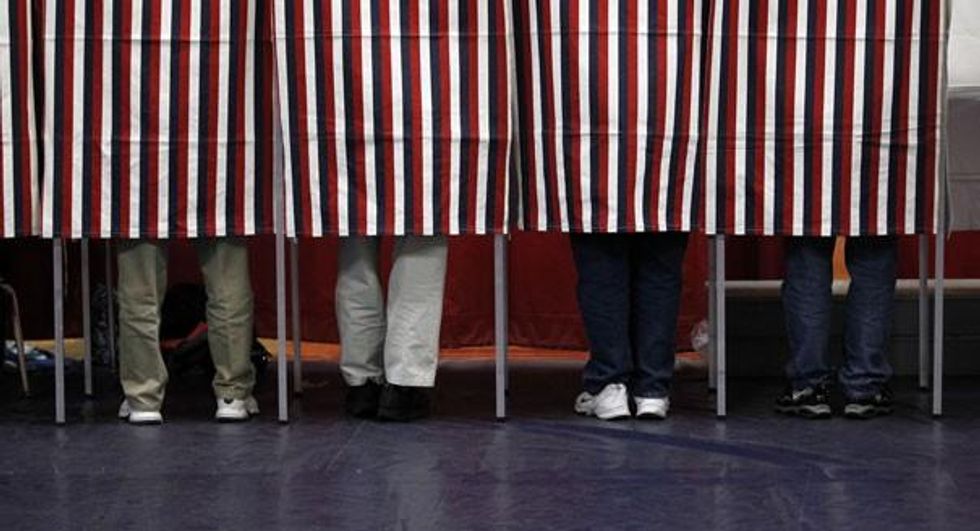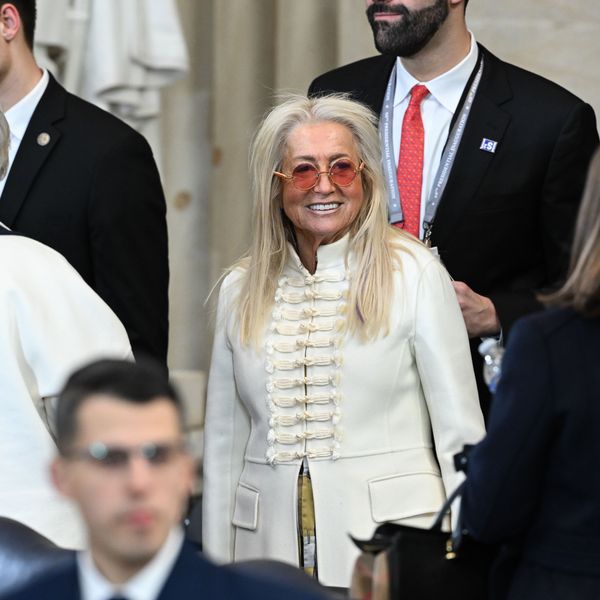Americans Self-Identifying as 'Liberal' on the Rise
Gallup poll shows liberal Democrats on the rise while conservatives leave Republican party for 'independent' label

"Americans' perceptions of their political views -- if not the views themselves -- are undergoing unmistakable change," Gallup reports, "contributing to greater political polarization in the country."
The shift comes mostly from Democrats, which Gallup suggests are increasingly leaning left. For the first time since Gallup began asking the question in 1992, a "plurality of Democrats consider themselves to be politically liberal, whereas a decade ago, Democrats were most likely to say they were moderate."
While conservatives still make up the majority of U.S. residents, the "conservative advantage" came down 15 percentage points in 2013 when liberals overall rose to 23% of the population and conservatives maintained their numbers at 38%. Those who identify as moderate decreased 9 points since 1992, with 34% now identifying in 2013.
Gallup reports:
When Gallup began asking about ideological identification in all its polls in 1992, an average 17% of Americans said they were liberal. That dipped to 16% in 1995 and 1996, but has gradually increased, exceeding 20% each year since 2005. [...]
The shift toward greater liberal self-identification has been led by Democrats. Currently, 43% of Democrats say they are liberal, a nearly 50% increase from 29% in 2000. Over the same period, the percentage of Democrats identifying as moderate is down to 36% from 44%, and conservative identification is down to 19% from 25%.
Within members of the Republican Party, 70% have consistently described themselves as conservative over the past several years, while 23% identify as moderate and 5% call themselves liberal.
Independents, who hit a record-high of 42% of Americans in 2013, on the other hand, are increasingly calling themselves conservative as members of the Republican party increasingly shift to the Independent label.
However, as Gallup reports, "If the trends in Democratic self-identification continue," the gap between those who identify as conservative and liberal "will likely continue to shrink over time."
_______________________
An Urgent Message From Our Co-Founder
Dear Common Dreams reader, The U.S. is on a fast track to authoritarianism like nothing I've ever seen. Meanwhile, corporate news outlets are utterly capitulating to Trump, twisting their coverage to avoid drawing his ire while lining up to stuff cash in his pockets. That's why I believe that Common Dreams is doing the best and most consequential reporting that we've ever done. Our small but mighty team is a progressive reporting powerhouse, covering the news every day that the corporate media never will. Our mission has always been simple: To inform. To inspire. And to ignite change for the common good. Now here's the key piece that I want all our readers to understand: None of this would be possible without your financial support. That's not just some fundraising cliche. It's the absolute and literal truth. We don't accept corporate advertising and never will. We don't have a paywall because we don't think people should be blocked from critical news based on their ability to pay. Everything we do is funded by the donations of readers like you. Will you donate now to help power the nonprofit, independent reporting of Common Dreams? Thank you for being a vital member of our community. Together, we can keep independent journalism alive when it’s needed most. - Craig Brown, Co-founder |

"Americans' perceptions of their political views -- if not the views themselves -- are undergoing unmistakable change," Gallup reports, "contributing to greater political polarization in the country."
The shift comes mostly from Democrats, which Gallup suggests are increasingly leaning left. For the first time since Gallup began asking the question in 1992, a "plurality of Democrats consider themselves to be politically liberal, whereas a decade ago, Democrats were most likely to say they were moderate."
While conservatives still make up the majority of U.S. residents, the "conservative advantage" came down 15 percentage points in 2013 when liberals overall rose to 23% of the population and conservatives maintained their numbers at 38%. Those who identify as moderate decreased 9 points since 1992, with 34% now identifying in 2013.
Gallup reports:
When Gallup began asking about ideological identification in all its polls in 1992, an average 17% of Americans said they were liberal. That dipped to 16% in 1995 and 1996, but has gradually increased, exceeding 20% each year since 2005. [...]
The shift toward greater liberal self-identification has been led by Democrats. Currently, 43% of Democrats say they are liberal, a nearly 50% increase from 29% in 2000. Over the same period, the percentage of Democrats identifying as moderate is down to 36% from 44%, and conservative identification is down to 19% from 25%.
Within members of the Republican Party, 70% have consistently described themselves as conservative over the past several years, while 23% identify as moderate and 5% call themselves liberal.
Independents, who hit a record-high of 42% of Americans in 2013, on the other hand, are increasingly calling themselves conservative as members of the Republican party increasingly shift to the Independent label.
However, as Gallup reports, "If the trends in Democratic self-identification continue," the gap between those who identify as conservative and liberal "will likely continue to shrink over time."
_______________________

"Americans' perceptions of their political views -- if not the views themselves -- are undergoing unmistakable change," Gallup reports, "contributing to greater political polarization in the country."
The shift comes mostly from Democrats, which Gallup suggests are increasingly leaning left. For the first time since Gallup began asking the question in 1992, a "plurality of Democrats consider themselves to be politically liberal, whereas a decade ago, Democrats were most likely to say they were moderate."
While conservatives still make up the majority of U.S. residents, the "conservative advantage" came down 15 percentage points in 2013 when liberals overall rose to 23% of the population and conservatives maintained their numbers at 38%. Those who identify as moderate decreased 9 points since 1992, with 34% now identifying in 2013.
Gallup reports:
When Gallup began asking about ideological identification in all its polls in 1992, an average 17% of Americans said they were liberal. That dipped to 16% in 1995 and 1996, but has gradually increased, exceeding 20% each year since 2005. [...]
The shift toward greater liberal self-identification has been led by Democrats. Currently, 43% of Democrats say they are liberal, a nearly 50% increase from 29% in 2000. Over the same period, the percentage of Democrats identifying as moderate is down to 36% from 44%, and conservative identification is down to 19% from 25%.
Within members of the Republican Party, 70% have consistently described themselves as conservative over the past several years, while 23% identify as moderate and 5% call themselves liberal.
Independents, who hit a record-high of 42% of Americans in 2013, on the other hand, are increasingly calling themselves conservative as members of the Republican party increasingly shift to the Independent label.
However, as Gallup reports, "If the trends in Democratic self-identification continue," the gap between those who identify as conservative and liberal "will likely continue to shrink over time."
_______________________

